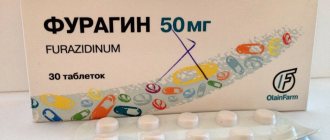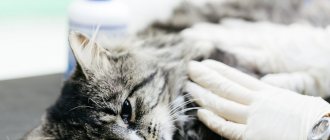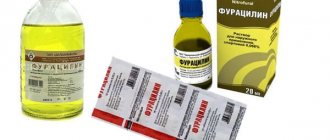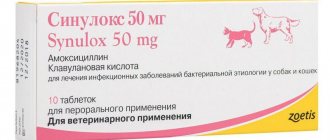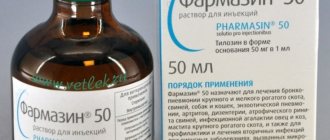The question often arises of how to treat the ears of kittens and adults. Is it necessary to buy expensive drugs in veterinary pharmacies or can you use drugs that are in every home medicine cabinet? Hydrogen peroxide has remained a universal remedy for treating affected skin surfaces for many years. It disinfects wounds, cleans festering scratches and places where splinters were removed. It is convenient to use peroxide to clean the ears of cats.
Features of the structure of the animal's auricle
A cat’s ear, like a person’s, consists of 3 sections:
- External: a funnel-shaped auricle, covered on the inside with a small amount of guard hairs and on the outside with hair, and the external auditory canal.
- Middle: includes the eardrum and the bony tympanic cavity, where the 3 auditory ossicles are located. They play one of the leading roles in the perception of sound.
- Internal: hollow bone formation in the temporal bone, the most complex section. It contains the receptor channels of hearing and the vestibular apparatus.
In humans, the auditory canal is straight and short, but in cats it bends and runs slightly at an angle. Due to ignorance of this feature, during cleaning you can create a sulfur plug that will block the passage.
The cat's ear can detect vibrations from 20 to 100,000 Hz. With the help of muscles and cartilage, the auricle rotates in different directions, which allows you to accurately determine the source of sound. All this makes animals excellent hunters.
Earwax formation and its role in the ear canal
The formation of sulfur is not a pathology, but a natural process. The ear secretion performs several important functions:
- lubricates and moisturizes the skin in the ear canal;
- provides protection against bacteria and fungi;
- prevents the ingress of dust, hair and skin particles, and insects.
All debris that enters the ear, thanks to the sulfur, clumps and comes out naturally. The cat brushes off the residue while washing.
If the production of wax is impaired, pathogenic bacteria easily enter the ear, causing animals to develop:
- otitis;
- dermatitis;
- otomycosis (fungal infection) and other diseases.
In healthy animals, earwax has a paste-like consistency, is light brown in color, and has virtually no odor. Changes in color, thickness, or the appearance of an unpleasant odor indicate the onset of the disease.
We treat ear mites in cats at home: get rid of mites using folk remedies
Otodectosis or ear scabies is one of the most common diseases in furry pets. The parasitic infection has not only an internal, but also an external form - nodtoedrosis.
Cat owners do not always know why brownish discharge, wax and blood clots have accumulated in their cat’s ears, which worries the animal. The cause of suffering is a tiny parasite that causes noticeable discomfort to cats of all ages. Why are ear mites dangerous in cats? Treatment at home, modern drugs and traditional methods, infection prevention are discussed in the article.
General information:
- ear mites are tiny arthropods that cause discomfort to your pet;
- the length of adult individuals is from 0.2 to 0.6 mm, the body is oval, elongated, color is light yellow;
- the development cycle takes up to twenty days;
- sufficient humidity and plenty of warmth in the ears of cats is an ideal environment for harmful arthropods to live and reproduce;
- the movement of parasites, blood sucking, and waste products cause inflammation of the auricle and excessive production of wax.
Ear mites are a tenacious parasite. The tiny arthropod can live outside the animal’s body for up to two months, with a maximum of 65 days. If during this period the blood-sucking arthropod does not find a new host, it dies.
How to get rid of earthen fleas in an apartment? Effective methods for killing parasites are described on this page.
Types of ear mites:
- Ototdectes cynotus. The parasite settles inside the ear canal, causing the disease otodectosis or ear scabies.
- Notoedres cati. This type of mite lives on the outside of the ear and causes the disease nodtoedrosis.
We suggest you familiarize yourself with Scabs on the neck and head of cats
The parasite that causes ear scabies is a small white mite that lives in the folds of the skin. It feeds on skin cells, lymph, intercellular fluid, and blood. The first sign of the disease is itching; the animal actively scratches its ears with its hind paws and shakes its head. Scratching appears on the head; when examining the ears, the following is observed:
- Redness of the skin, especially in the folds.
- Increased earwax volume means dirty ears.
- Tick waste is a brown coating with a noticeable unnatural odor. In a progressive form, the ears are literally filled with a wet mush of brown mite secretions, wax, coagulated blood, and skin scales. The photo shows an advanced stage of an ear mite.
Before choosing a medicine for ear mites in cats, make sure you have a diagnosis. Many skin diseases and allergies cause itching in the ear area, and brown discharge can have several underlying causes.
When to clean your cat's ears
Ear cleaning is conventionally divided into 2 types:
- preventive;
- medicinal.
Preventive cleaning of the inner surface of the ear from wax and dust is carried out approximately once a month. The exact timing depends on the breed, activity level, diet and individual characteristics of the animal.
Therapeutic cleaning is carried out before treating against ticks, using antibiotics and antifungal drugs. That is, if the animal is prescribed special drops or rinsing, then you first need to clean the auricle with saline solution or lotion.
The procedure is repeated each time the medication is added. This is due to the fact that parasites and pathogenic bacteria produce multiple by-products. And they interfere with the effective effects of drugs. Cleaning is carried out in accordance with the veterinarian's instructions until complete recovery.
How to identify ear mites
- You will need a flat black surface. Exactly black! The ear mite has a white color, but is literally microscopic in size, so the surface should be as contrasting as possible.
- Using a cotton swab, take a swab from the animal's ear. Try to grab as much of the mixture as possible, but take the smear in one motion.
- Holding the stick over the black surface, gently tap on its base - you need to “shake out” the mites from the general mass of secretions.
- Place the stick in the bag, shine a bright light on the surface and look carefully. If you have vision problems, use a magnifying glass.
- Your task is to detect white dots, which, after lying down for a while, will begin to move. Found it? – you have confirmed the diagnosis, the cat has ear mites.
If the examination does not yield results, most likely you are dealing with parasites that cannot be seen without a microscope. The only method for identifying the type of pathogen is laboratory scraping. The procedure is elementary! Even if there is no veterinarian nearby, you can contact the state sanitary station; laboratory staff have the necessary equipment at their disposal and will be able to distinguish the type of tick.
How can you perform a hygiene procedure?
To clean your cat's ears at home, you need a water- or oil-based cleansing lotion. It effectively dissolves sulfur deposits and dirt and does not cause allergic reactions.
It is preferable to use oil-based ear cleaners. They are gentler and less irritating to the skin.
There are lotions with regenerative, bactericidal, anti-inflammatory, and antiparasitic properties. To choose a brand for a specific pet, it is better to consult a veterinarian. He will recommend a product that suits the needs and individual characteristics of the cat.
Important. The lotion should not contain antibiotics or alcohol. These substances destroy beneficial microorganisms that protect the cat's ears from pathogenic bacteria.
The following ear cleaning products have proven themselves to be effective:
- Leopard - has anti-inflammatory, analgesic and anti-edematous properties.
- Euracon Pharma Otoklin - removes dead skin particles, softens wax and moisturizes the auricle. Recommended for cats prone to otitis media.
- Vetoquinol Otifri - effectively removes sulfur and dirt, eliminates itching, improves microflora.
- Veda - contains plant extracts, has antiseptic, healing and anti-inflammatory properties.
Do not use iodine, cologne, hydrogen peroxide, soap solutions or other liquids for cleaning. They can burn delicate skin and increase the production of ear secretions. Various powders or powders are also not recommended. Mixing with sulfur, they lead to the formation of traffic jams.
Properly clean your cat's ears using cotton pads or a sterile bandage. Cotton swabs or matches with cotton wool wrapped around them will not work. It's not that the long object will pierce the eardrum - it just won't reach it. But there is a high risk of compressing the sulfur into the cork, which will injure the membrane.
There are also cases where the cotton wool jumped off the stick and remained in the ear canal. Most often it can only be removed surgically. Therefore, cotton swabs are used if only the upper part of the ear needs cleaning.
Can a cat be treated with hydrogen peroxide?
Pet owners often prefer to use conventional and affordable pharmaceutical products to treat their pets.
Hydrogen peroxide for cats is used to treat wounds, clean ears, and get rid of the parasite - ear mites. The use of this substance is controversial; it is necessary to determine whether it is safe or can cause harm to the health of the animal. Having a cat in the house obliges a person to feed and care for the animal well. The treatment process should be given great attention, since they are susceptible to many diseases, including ear mite damage. Every owner should know how to promptly diagnose and eliminate the disease at home using folk remedies.
Cleaning technique
Cats are taught hygiene procedures from early childhood. It is advisable to periodically pick up the kitten and touch its ears. Then you can carefully examine them.
When the baby begins to calmly perceive all the manipulations, they move on to the procedure itself.
For your information. Kittens can have their ears cleaned starting at 8 weeks.
A kitten's ears need to be cleaned in the same way as an adult cat. Veterinarians recommend developing the right approach to sanitation:
- Choose a moment when the cat is relaxed, not sleeping, not playing, not eating or licking itself.
- Place on your lap or any hard surface. Stroke and soothe.
- Secure the cat's head. Drop about 0.5 ml of lotion into the ear. The liquid should be warm. If it was in the refrigerator, you should first leave it in the room for a while.
- Gently, without applying too much pressure, massage the base of the ear for 30-60 seconds so that the liquid is evenly distributed. If you do everything correctly, you will hear a characteristic squelching sound.
- Release the cat. She will begin to shake her head, trying to get rid of the strange sensations in her ears.
- After this, take your pet in your arms and wipe the inside of the ear dry with a cotton pad or bandage, simultaneously removing wax and dirt. No need to go too deep. There is a high risk of causing pain and injury to the cat during the cleaning process.
- It is important that there is no moisture left inside. Subsequently, the liquid will not be able to evaporate from the tortuous ear canal and will lead to the development of inflammation, because it serves as a breeding ground for bacteria.
Instructions for use
Treatment of cats with hydrogen peroxide requires the owner to comply with the following principles of therapy:
If the animal’s skin was damaged more than 2 hours ago, then there is no point in using the drug.
- Use the substance no later than 2 hours after injury to the skin.
- It is good to secure the kitten in your arms so that it cannot resist. The assistance of a second person may be required.
- Do not use hydrogen peroxide for an extended period as cell death may occur.
When treating wounds
If the kitten is injured, it should be treated as soon as possible. The owner will need to arm himself with a cotton swab, which must be soaked in hydrogen peroxide. Then, using it, you need to carefully treat the damaged area of the skin. Veterinarians recommend applying a sterile bandage to the treated area to prevent the cat from licking the wound.
Otherwise, the possibility of poisoning and vomiting cannot be ruled out.
From parasites
After using this antiseptic, you can proceed to instilling the necessary drug into the animal’s ears.
If we are talking about ear mite therapy, the owner will need to act following the following algorithm of actions:
- It is good to restrain the cat so that it does not resist and cannot scratch the owner.
- Take cotton sponges and soak them in a 2% hydrogen peroxide solution.
- Carefully treat the ears.
- Use the medication prescribed by your veterinarian. To get rid of ear mites, ointments, creams, and drops are used.
In case of poisoning
If your kitten is diagnosed with poisoning, it may be necessary to induce vomiting. For these purposes, a 3% solution of the substance is used. For 2.5 kg of cat's body weight you will need to take 5 ml of hydrogen peroxide. The medication is drawn into a syringe without a needle and carefully poured into the oral cavity. The medication will need to be given every 10 minutes until at least 3 doses have been ingested by the pet. It is important to administer the product carefully. First of all, you will need to place the syringe behind the fangs and gently press the plunger. No more than 1 milliliter of hydrogen peroxide should drip onto the tongue. Then the owner will need to wait for the cat to swallow, and then pour in the next milliliter. It is strictly forbidden to administer the entire amount of the substance at once, since the cat may choke and the substance will end up in the lungs.
Ear examination
A thorough examination once a week helps to detect the disease in time and eliminate it at an early stage. In normal condition, the ears should be warm, clean and slightly oily to the touch.
If your cat walks outside on its own, it is advisable to inspect its ears daily. She can injure them in a fight with other four-legged animals or pick up a tick. It is possible that a foreign object has entered.
To inspect, simply bend back the ear and look inside. You can use a flashlight to make the most secluded corners visible.
What symptoms should alert the owner?
The onset of a disease or inflammatory process in a cat’s ear is indicated by the following signs:
- skin redness;
- local temperature increase;
- swelling and narrowing of the ear canal;
- darkening or lightening of sulfur;
- bloody issues;
- unpleasant specific odor;
- squelching sounds when pressing on the ear;
- excessive release of sulfur;
- accumulation of fluid or pus;
- hearing impairment.
Illness is indicated by changes in behavior. When a cat experiences discomfort, it shakes its head or bends it to one side. If you touch the ear, the pet will pull it away and try to run away. The animal often itches, which only increases the discomfort.
Sometimes small black inclusions are found in the sulfur. Most likely it's just dirt. But if, after cleaning, small inflamed areas become visible on the skin, you should contact your veterinarian.
Almost black sulfur and bloody stains indicate the presence of a mite. Colorless or milky discharge may indicate a lack of any microelements and incipient hypovitaminosis.
An ear that is too dry, wax that flakes off in whitish scales are symptoms of a lack of fat or dermatitis. Clear discharge from the ears, nose and eyes are signs of an allergic reaction.
The smell of fish appears in the ears with staphylococcus, and the smell of rotten meat - with suppuration. In any case, consultation with a veterinarian is necessary. Only a specialist will be able to correctly determine the cause of the pathology and prescribe appropriate treatment.
Cleaning a cat's ears at home is quite simple if you have certain knowledge and skills. It is important to regularly examine the ears in order to notice an emerging problem in time.
Hydrogen peroxide solution – Solutio Hydrogenii peroxydi diluta. GROUP OF DRUGS OXIDIZERS.
- Colorless transparent liquid, with a weak specific odor, slightly acidic reaction. Decomposes under the influence of light, upon boiling, and also upon contact with organic and other easily oxidized substances.
- The solution contains about 3% hydrogen peroxide.
- Available in bottles with ground-in stoppers.
- Upon contact with organic substances, atomic oxygen released from hydrogen peroxide has a bactericidal and sporicidal effect. Of great importance is the ability of the drug to release oxygen bubbles and form foam upon contact with the purulent surface of the wound and, therefore, free the wound cavity from contamination and dead tissue.
- It also provides aeration of the wound defect, which is of no small importance in the treatment of wounds complicated by aerobic infection.
- When hydrogen peroxide is applied to animal tissue, it moderately irritates the receptors, thereby providing an astringent effect and a slight hemostatic effect. When 5 ml of a 3% hydrogen peroxide solution is ingested, dogs vomit. Used as an antiseptic for treating wounds, washing inflamed areas of the mucous membrane, and for stomatitis. In surgical practice, a 3% solution of hydrogen peroxide is used to wash purulent wounds, ulcers, cavities, and also to remove stuck bandages.
- In case of bites from poisonous snakes and spiders, a 3% solution of hydrogen peroxide 1-5 ml is injected subcutaneously around the bite site.
What are the healing properties of peroxide?
The substance is a solution that is prescribed for the treatment of damage to the skin and mucous membranes. Veterinary medicine involves the use of hydrogen peroxide to treat wounds, including purulent wounds, various scratches, and ulcers. With the help of this substance, it is possible to rid the affected area of the skin of pathogenic microorganisms, remove dirt, pus and blood. The mechanism of action of the drug is based on the release of active oxygen from tissues, which makes it possible to achieve protection against pathogenic bacteria and cleanse injured areas of the skin from dead cells.
The main causes of wax discharge from the ears
A common cause of excessive secretion of sulfur in cats that are picked up from the street or have access there is. At the same time, there is a huge amount of wax in the cat’s ear, the cat constantly shakes its head, and its ears are noticeably bothered. He will scratch them and poke his paw into them. This behavior is a good reason to visit a doctor.
Since it is a microscopic mite, it cannot be detected with the naked eye.
Diagnosis of ear mites
If your cat constantly tilts his ear or rubs it, ear mites may be a possible cause.
Diagnosing the presence of ear mites is quite simple. The veterinarian takes a swab from the affected ear with a cotton swab and transfers the discharge onto a glass slide. Then, using microscopy, he identifies or does not detect ticks or their eggs there. Treatment for ear mites is long but effective.
Otitis (internal, middle and external)
Timely diagnosis and a properly selected treatment regimen will help rid your cat of otitis media without any problems.
Another cause of dirty ears and anxiety can be ear infections. Otitis can be internal, middle ear and external. This is inflammation of the ear, respectively, the inner, middle and outer.
Inflammation can be caused by bacteria or fungi
. The latter are Malassezia yeasts, which are more often reported as a cause of otitis media in dogs than in cats, but such cases do occur.
Malassezia
- This is part of the normal microflora of the skin and ear canal of animals, but when the body’s resistance weakens, they can begin to actively grow and provoke inflammation. Bacteria are also normally present in some quantities in the ear, and also cause otitis media if the body's defenses are weakened. Bacteria and Malassezia can also be seen in an ear smear under a microscope, but the smear must also be stained. Usually, infection of the ear canal by a fungus is accompanied by a specific odor.
Allergic cause
A swab from a cat's ear can rule out an infectious cause of inflammation of the cat's ear. In this case, it may be a banal allergic reaction.
If the swab from the ear is clear, an allergic cause of ear problems is possible. - a common phenomenon. And often the ears are also involved in the pathological process. They swell, turn red, and may itch. There may not be a large amount of sulfur.
Allergies can be triggered by various environmental factors
, among which nutrition plays an important role. Unfortunately, it is not possible to determine what an animal is allergic to, so you have to use the exclusion method, or immediately switch to hypoallergenic food.
Due to their breed, some cats may have ear problems more often than others. The anatomical features of the structure of the auricle can provoke heating, which causes increased growth of fungi and bacteria.
How to wash a kitten's ears?
It is better to entrust their choice to a veterinarian. So, the kitten is fixed, and the product is injected according to the instructions onto the inner surface of the ear. Usually this is 3-5 drops. After this, the product must be dripped directly into the ear canal, in the amount of 5-10 drops. Next, you need to lightly massage the base of the cat’s ear for 30 seconds.
This is necessary for uniform distribution of the product in the ear canal. After this, the cat must be released. She will shake her head as usual, and softened plaque will come out of the ear canals. It is then easily removed with cotton swabs and sticks.
Price: 49 rub.
78 rub.
37% discount for you!
With cornflower flower extract and vitamin A. Fast delivery throughout Russia. And also more than 3,000 other pet products at competitive prices!
Cat care – 1
The corners of the eyes are usually cleaned with a small damp cloth daily. Cotton wool and cotton swabs are not suitable; its fibers irritate the cornea. The eyes of Persians and Exotics require especially careful care; due to shortened tear ducts, their eyes often water, forming stains that are difficult to remove. To care for watery eyes, you can use a special solution (drops) for the eyes or “Optic gel”. For severe inflammation, doctors recommend using drops of chloramphenicol solution or tetracycline eye ointment.
Check your cat's ears once a week: the ear shells should be clean, free of rashes and plaque. Use a cotton swab to gently clean your ears. A healthy animal has light, odorless sulfur. Black, greasy, loose plaque in the ear indicates infection with ear mites.
Cat care – 1
The corners of the eyes are usually cleaned with a small damp cloth daily. Cotton wool and cotton swabs are not suitable; its fibers irritate the cornea. The eyes of Persians and Exotics require especially careful care; due to shortened tear ducts, their eyes often water, forming stains that are difficult to remove. To care for watery eyes, you can use a special solution (drops) for the eyes or “Optic gel”. For severe inflammation, doctors recommend using drops of chloramphenicol solution or tetracycline eye ointment.
Check your cat's ears once a week: the ear shells should be clean, free of rashes and plaque. Use a cotton swab to gently clean your ears. A healthy animal has light, odorless sulfur. Black, greasy, loose plaque in the ear indicates infection with ear mites.
Some animals develop tartar at a very early age - at one and a half to two years.
It develops from plaque and accumulates primarily on the molars. During a preventive veterinary examination, it is necessary that the veterinarian remove tartar.
To prevent the formation of tartar, you can thoroughly wipe your teeth once a week with a cloth or cotton swab moistened with a weak solution of hydrogen peroxide. You should not use toothpowder or toothpaste for this. Check your cat's mouth regularly. Redness of the gums and a thin red line above the neck of the tooth are the first signs of periodontal disease. Gum sores, odor, or excessive salivation may be signs of serious dental disease or stomatitis that require veterinary treatment.
How to clean a kitten's ears?
In order to properly clean a kitten’s ears, first of all, it is necessary to immobilize the animal so that it does not jerk at the most inopportune moment and get injured. It is better to act together, when one person holds the kitten, and the second treats the ears. The animal can be held in your arms or placed on its side and only held.
If it actively moves and breaks out, it is recommended to swaddle it, leaving only the head free. If this hygienic procedure is carried out regularly, the baby gets used to it and takes it for granted. It is advisable to treat your baby with his favorite treat at the end to compensate for unpleasant moments and create motivation.
To treat the kitten's ears we will need cotton pads, ear swabs and boiled, cooled water. You can use special lotions purchased at a veterinary pharmacy. So, the kitten's ear is carefully opened with the thumb and forefinger. After a thorough external inspection, you can proceed directly to cleaning.
This is done with careful movements using a swab soaked in water or lotion and cotton swabs. You should move from inside to outside. You should also remove dirty, matted hair, which creates a favorable environment for the development of bacteria and prevents the passage of air to the ear canal.

